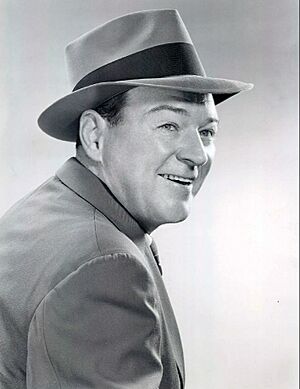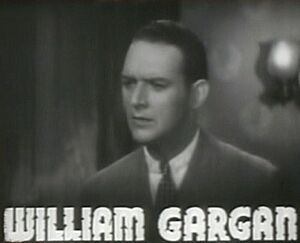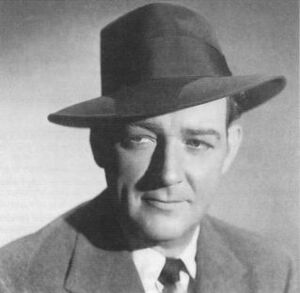William Gargan facts for kids
Quick facts for kids
William Gargan
|
|
|---|---|

Gargan in c. 1950s
|
|
| Born |
William Dennis Gargan
July 17, 1905 Brooklyn, New York, U.S.
|
| Died | February 16, 1979 (aged 73) |
| Occupation | Actor |
| Years active | 1925–1958 |
| Spouse(s) |
Mary Kenny
(m. 1928) |
| Children | 2 |
William Dennis Gargan (born July 17, 1905 – died February 16, 1979) was an American actor. He worked in movies, on television, and on the radio. In 1967, he received the Screen Actors Guild Life Achievement Award. This is a special award given to actors who have had a great impact on the acting profession. In 1941, he was nominated for an Academy Award for Best Supporting Actor for his role in the movie They Knew What They Wanted.
Gargan acted in many movies, including Follow the Leader, Rain, and Night Flight. He was most famous for playing a private detective named Martin Kane in the radio and television series Martin Kane, Private Eye from 1949 to 1952. He also appeared in 39 episodes of The New Adventures of Martin Kane on TV.
Contents
Early Life and Education
William Gargan was born in Brooklyn, New York, on July 17, 1905. His parents, Bill and Irene, had seven children, but only William and his brother Ed lived past infancy. His mother used to be a teacher. William went to St. Francis Xavier grade school and then to St. James High School in Brooklyn.
When he was seven years old, Gargan got his first job in a silent movie at Vitagraph Studios. He earned three dollars and eighty-five cents, which would be worth about one hundred twenty dollars today. Both William and his brother Ed were big kids. William often spent time at his father's place of business in Sunset Park, Brooklyn.
Gargan grew up spending summers at Sea Gate. He played baseball and basketball for his schools. He also enjoyed playing pool and sometimes snuck into Ebbets Field to watch the Dodgers play.
When he was fourteen, William met Mary Elizabeth Kenny while working at the Prospect Park skating rink. They spent time together in Coney Island and other fun places in Brooklyn. They got married in 1928.
Even though Gargan didn't love school, he really enjoyed theater. In high school, he acted in school plays like Hamlet and Romeo and Juliet. He left high school before graduating. After school, he had several different jobs, including working as an investigator and selling cooking oil.
Acting on Stage
William's brother, Edward, was also an actor. One day, William met a writer named Le Roy Clemens, who was holding tryouts for a play. William read a line and was hired for the play Aloma of the South Seas. The play opened in Baltimore in 1924. William learned quickly and even started directing the play's production in Philadelphia within a year. Aloma of the South Seas ran for forty weeks.
Movie Career
Gargan's first movie was Rain. He later appeared in Misleading Lady and many other Hollywood films. He even starred as the detective Ellery Queen in three movies.
He often played characters like policemen, priests, reporters, and brave adventurers. In 1945, he played Joe Gallagher in The Bells of St. Mary's, which starred famous actors Bing Crosby and Ingrid Bergman.
In 1935, Gargan traveled to England and made several movies there. In 1940, he was nominated for an Academy Award for Best Supporting Actor for his role as Joe, a foreman, in the movie They Knew What They Wanted.
Radio and Television Roles
William Gargan's first regular role on radio was Captain Flagg in Captain Flagg and Sergeant Quirt, which started in 1942. He also played Ross Dolan in I Deal in Crime and Inspector Burke in Murder Will Out. He was also the host of a show called G. I. Laffs.
In 1949, Gargan was in New York City and spoke with Frank Folsom of RCA. Folsom invited him to a meeting where Gargan mentioned he was looking for a job in television. Soon after, he was offered a role as a pipe-smoking detective, sponsored by a tobacco company. This show became Martin Kane, Private Eye. It was made for both TV and radio. The radio version started on August 7, 1949, and the TV version aired on NBC.
Martin Kane, Private Eye was a live show and became the first detective series on network TV to have a huge number of viewers. Gargan made the show special by developing a fun, light-hearted style. The show was very popular, ranking twelfth overall in TV ratings for the 1950-51 season.
After eighty-five weeks, William Gargan left the show, and another actor, Lloyd Nolan, took over the role of Martin Kane. Soon after, Gargan signed a deal to create a new private eye show for NBC. This show was called Barrie Craig, Confidential Investigator, and it ran from 1951 to 1955. On television, Gargan starred in 39 episodes of Martin Kane, Private Eye and later in the syndicated show New Adventures of Martin Kane in 1957–58.
Later Years and Health
In 1960, William Gargan was planning to act in a play called The Best Man. He was supposed to play a former president who was dying. However, he developed laryngitis, which led to tests on his throat. Doctors discovered he had throat cancer. On November 10, 1960, they had to remove his larynx (voice box). A small opening, called a stoma, was made in his throat to help him breathe.
For a while, he felt sad, but his friends, including Bing Crosby and Phil Harris, visited him often. He also wanted to speak again. In January 1961, he started taking vocal lessons through The American Cancer Society.
In 1963, he met President Kennedy. He had another meeting planned with the President for November 23, 1963, but it did not happen. His brother Ed passed away in 1964. That same year, Gargan was hired by the American Cancer Society to work full-time on their national staff.
Within three years, Gargan became very good at esophageal speech, a way of speaking without a voice box. People felt he sounded almost like he did before his surgery. He worked hard to speak in different tones and refused to use a voice amplifier. He often thanked his wife, Mary, for helping him not give up.
In 1965, Mutual of Omaha gave Gargan its annual Criss Award. This award recognized his amazing efforts to recover and his contributions to helping others with similar challenges. Since he could no longer act, he started his own company, William Gargan Productions, which made movies and TV films.
Family Life
William Gargan and his wife, Mary, were married on January 19, 1928. They had two sons. Their first son, Bill (nicknamed Barrie), was born on February 25, 1929. Their second son, Leslie, was born on June 28, 1933.
On February 16, 1979, while on a flight from New York City to San Diego, William Gargan had a heart attack. He was lecturing for the American Cancer Society at the time. He passed away upon arrival at San Diego Center City Hospital. He was buried at Holy Cross Cemetery in San Diego, California. He was survived by his wife, his two sons, and three grandchildren.
Partial Filmography
- Lucky Boy (1928)
- Follow the Leader (1930)
- His Woman (1931)
- Partners (1931, short)
- Misleading Lady (1932)
- Rain (1932)
- The Sport Parade (1932)
- The Animal Kingdom (1932)
- Lucky Devils (1933)
- Sweepings (1933)
- The Story of Temple Drake (1933)
- Emergency Call (1933)
- Headline Shooter (1933)
- Night Flight (1933)
- Aggie Appleby Maker of Men (1933)
- Four Frightened People (1934)
- The Line-Up (1934)
- Strictly Dynamite (1934)
- British Agent (1934)
- A Night at the Ritz (1935)
- Traveling Saleslady (1935)
- Black Fury (1935)
- Don't Bet on Blondes (1935)
- Bright Lights (1935)
- Broadway Gondolier (1935)
- Things Are Looking Up (1935)
- Man Hunt (1936)
- The Milky Way (1936)
- The Sky Parade (1936)
- Mariners of the Sky/Navy Born (1936)
- Blackmailer (1936)
- Alibi for Murder (1936)
- Fury and the Woman (1936)
- Flying Hostess (1936)
- You Only Live Once (1937)
- Breezing Home (1937)
- Wings Over Honolulu (1937)
- Reported Missing (1937)
- She Asked for It (1937)
- Behind the Mike (1937)
- Some Blondes Are Dangerous (1937)
- You're a Sweetheart (1937)
- The Crime of Doctor Hallet (1938)
- The Devil's Party (1938)
- The Crowd Roars (1938)
- Personal Secretary (1938)
- Within the Law (1939)
- The Adventures of Jane Arden (1939)
- Broadway Serenade (1939)
- Women in the Wind (1939)
- The House of Fear (1939)
- Three Sons (1939)
- The Housekeeper's Daughter (1939)
- Joe and Ethel Turp Call on the President (1939)
- Double Alibi (1940)
- Isle of Destiny (1940)
- Star Dust (1940)
- Turnabout (1940)
- Sporting Blood (1940)
- They Knew What They Wanted (1940, Nominated – Academy Award for Best Supporting Actor)
- Cheers for Miss Bishop (1941)
- Flying Cadets (1941)
- I Wake Up Screaming (1941)
- Keep 'Em Flying (1941)
- Sealed Lips (1942)
- Bombay Clipper (1942)
- A Close Call for Ellery Queen (1942)
- A Desperate Chance for Ellery Queen (1942)
- Miss Annie Rooney (1942)
- The Mayor of 44th Street (1942)
- Enemy Agents Meet Ellery Queen (1942)
- Destination Unknown (1942)
- Who Done It? (1942)
- No Place for a Lady (1943)
- Harrigan's Kid (1943)
- Swing Fever (1943)
- The Canterville Ghost (1944)
- She Gets Her Man (1945)
- Song of the Sarong (1945)
- Midnight Manhunt (1945)
- The Bells of St. Mary's (1945)
- Follow That Woman (1945)
- Behind Green Lights (1946)
- Strange Impersonation (1946)
- Night Editor (1946)
- Murder in the Music Hall (1946)
- Rendezvous 24 (1946)
- Hot Cargo (1946)
- Till the End of Time (1946)
- Swell Guy (1946)
- The Argyle Secrets (1948)
- Waterfront at Midnight (1948)
- Dynamite (1949)
- Miracle in the Rain (1956)
- The Rawhide Years (1956)
Radio Appearances
| Year | Program | Episode/source |
|---|---|---|
| 1943 | Philip Morris Playhouse | Roberta |
Book
William Gargan wrote a book about his life called Why Me?, which was published in 1969. People who read the book said it was an inspiring story about his life, his beliefs, and his courage.



